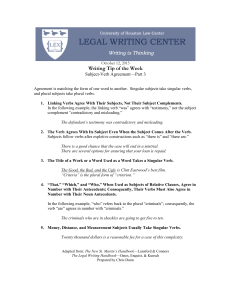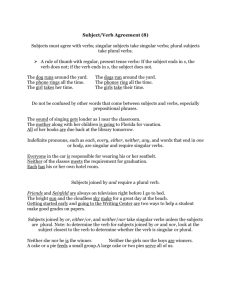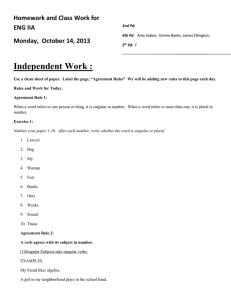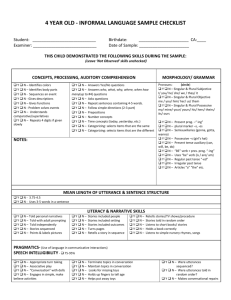UNIVERSITY OF WARWICK Department of English & Comparative Literary Studies
advertisement
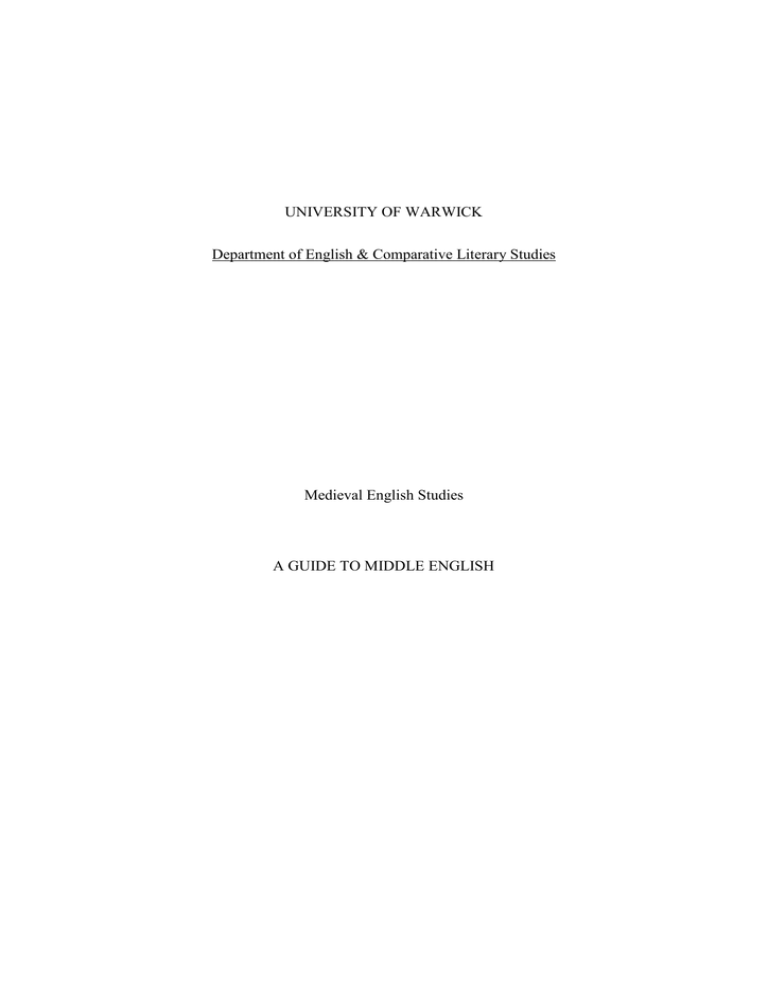
UNIVERSITY OF WARWICK Department of English & Comparative Literary Studies Medieval English Studies A GUIDE TO MIDDLE ENGLISH A Guide to Middle English: Introduction One of the aims of the course is that you should acquire sufficient knowledge of Middle English to read the medieval set-texts in the original language. In order to test this skill, the examination for the course includes some translation from Middle English as well as commentary on Middle English texts. As you read through the texts set for the first term, consulting the notes and glossaries as you go, you will pick up most of what you need to know about Middle English. The purpose of this guide is to bring together some basic information to help you, and to list vocabulary you might wish learn week by week. During the first term, your private reading will be supported by textual classes, which include reading practice, translation techniques and other work on the language of extracts from Sir Gawain and the Green Knight. (The sections set for the language classes are listed at the end of this booklet.) The course is concerned with texts from the late fourteenth century and after, so the grammatical notes and vocabulary below apply to that period. The guide does not aim to be exhaustive. (Some suggestions for further reading on Middle English can be found below.) Tutors welcome comments on the guide and suggestions for improvement. NOTE: If you are unfamiliar with the grammatical terminology used in this guide, you might find it useful to buy a grammar book, or borrow one from the library. The words used are the technical terms relating to grammar and language, and you will be expected to understand, and sometimes to use, them. 1 General The term Middle English describes the stage in the development of the English language between 1100 and 1500; it falls between Old English (also called Anglo-Saxon) and the beginnings of Modern English in the sixteenth century. The Middle English period was one of great linguistic change: the vocabulary grew by leaps and bounds, and there were fundamental changes in the grammar of the language. Old English had been highly inflected (i.e., grammatical relationships were indicated by word endings) with a rather free word order. In an inflected language, both calls John Mary and John Mary speaks are valid options, because both John and Mary have distinctive endings to show their grammatical relationship (who is doing what to whom). In contrast, Middle English, like Modern English, uses prepositions (John speaks to Mary) or a logical word order (John calls Mary) to indicate many grammatical relationships, and in consequence the word order is more fixed. Old English texts that have survived are mainly in the language of a single region (West Saxon); while, since the advent of printing, modern literary English has mainly conformed to a standard London English. In the Middle English period, literature was produced in many different dialects, which were influenced by different languages. Thus, Chaucer’s English contains many more words derived from French and Latin than do the northern dialects, which retained a stronger Germanic influence from their Anglo-Saxon predecessor as well as absorbing many Norse words from the Viking invaders who settled in the north; and dialect influenced inflections as well as vocabulary. This means that northern texts, in comparison with southern ones, tend to contain more words that 2 are unfamiliar to users of Modern Standard English. The notes that follow concentrate on Chaucerian forms (London and East Midlands). Most of the examples below are taken from The Canterbury Tales – The Miller’s Tale (MT), The Pardoner’s Tale (PT), or The General Prologue (GP) – and cited by line number. It is useful to remember that there is no standardized spelling in Middle English, and a single text often uses variant spellings of the same word. There is a valuable account of Chaucer’s language in the set-text, The Riverside Chaucer; while more general issues of Middle English are discussed in greater detail in histories of the English language, such as R. W. Burchfield, The English Language (1985, classmark 420 (external store)), chapters 2–4; A. C. Baugh, A History of the English Language (various editions; 4th edn, 1993, classmark PE1075.B2); B. M. Strang, A History of English (1970, classmark PE1075.S8). If you would like to develop your understanding further, you can find detailed information on Middle English and its grammar in J. A. Burrow and Thorlac Turville-Petre, A Book of Middle English (various editions; 3rd edn, 2005, classmark PE535.B8; and e-book). 2 Inflexions Inflexions are changes in words or additions to words, usually the word endings, which provide information about number (whether a verb or a noun is singular or plural), gender, or tense. a) Verbs There are, of course, some irregular verbs; but most verbs in the present tense add an ending to the stem (bind in the following examples): –e in the first person singular (I binde), –est in the second person singular (thou bindest), –eth in the third person singular (she bindeth), and –en in all plural forms (we/ye/they binden). Modern English uses an identical form for the singular and plural versions of the second person, but they were differentiated in Middle English: singular thou/thy and plural ye/you/your. Middle English has more inflections than Modern English, but the system is simple enough: Singular Plural Middle English Modern English 1 2 3 1 2 3 I tell You tell He/She/It tells We tell You tell They tell I telle Thou tellest He/She/It telleth We tellen Ye tellen They tellen The ending –eth can also indicate the singular imperative: Refuseth nat (Do not refuse). With the past tense, it is necessary to begin by making a distinction, which still applies in Modern English, between strong and weak verbs. Strong verbs form the past tense by changing their stem (thus, I sing, I sang; you throw, you threw), while weak verbs add to the stem (I wish, I wished; you laugh, you laughed). 3 In the past tense in Middle English, strong verbs change their stems (so sing becomes sang or song) and also add –e in the second person singular (thou songe) and –en in the plural (they songen). Weak verbs add –de or –te, so here becomes herde, fele becomes felte; the second person singular takes the ending –st (thou herdest) and plural forms taken –n (they felten). The table below compares the past tense in Middle and Modern English for strong and weak verbs. Strong Verbs Middle English Modern English Present stem: ‘sing’ Singular Plural 1 2 3 1 2 3 I sange (or soonge) Thou songe He/She/It sange We songen Ye songen They songen I sang You sang He/She/It sang We sang You sang They sang Weak Verbs Middle English Modern English Present stem: ‘here’ Singular Plural 1 2 3 1 2 3 I herde Thou herdest He/She/It herde We herden Ye herden They herden I heard You heard He/She/It heard We heard You heard They heard The past tense is often formed using the auxiliary verb gan with the past participle: Absolon gan wype his mouth (MT 3730) means ‘Absolon wiped his mouth’; The folk gan laughen (MT 3840) means ‘the people laughed’. Where gan is used with an infinitive verb (usually with the particle ‘to’), it can ‘began’: so he gan to crye (MT 3814) means ‘he started to shout’. However, frequently these cases also need to be translated using the simple past tense: gan to rynge (MT 3655) means ‘rang’. The context should help you select the most logical translation. Some verbs add an initial y or i to the past participle: for instance, ycleped, ‘called’ (MT 3313); ycrowe, ‘crowed’ (MT 3357). b) Nouns and Adjectives Plural nouns are generally formed by adding –s or –es to the singular noun: shoures, ‘showers (MT 3196), lords, ‘lords’ (MT 3581). Irregular forms appear occasionally; for instance, The Merchant’s Tale offers instrumentz (1713). Note that possessives are formed in the same way as plural nouns – the Kynges Noote, ‘the King’s Tune’ (MT 3217); Goddes pryvetee, ‘God’s secrets’ (MT 3454) – and take care not to confuse the two. (There are no apostrophes in Middle English to show possession, although modern editors sometimes insert them to indicate an elision, e.g. th’ encrees (GP 275)). 4 Some nouns add –en for plural, such as eyen, ‘eyes’ (MT 3317), and a few have the same form in the singular and the plural; for instance, compare o thing, ‘one thing’ (MT 3583) with certeyn thing, ‘certain things’ (MT 3494). There are also a few mutated plurals, some of which have survived into Modern English: thus singular man (MT 3450) mutates into plural men (MT 3491). Most adjectives do not take a plural ending, although monosyllabic adjectives add –e to pluralize: a yong squire (GP 79), but yonge women (GP 213). In some circumstances an –e is added in the singular, such as when the adjective appears with a definite article (the yonge sonne, GP 7) or with a demonstrative article (this yonge wyf, MT 3233; that ilke nyght, MT 3584). c) Adverbs Some adjectives are converted to adverbs by the addition of –e, such as faire, ‘fairly’ (MT 3289), brighte, ‘brightly’ (MT 3352). d) Personal Pronouns The forms of the personal pronouns are somewhat different from those used in Modern English, so are reproduced here in full: Subject Singular Plural 1 I, ich 2 thou, thow 3 masculine he 3 feminine she, ho 3 neuter it, hit 1 we 2 ye 3 they Object Possessive me thee hym, him her it, hit us you, yow hem myn, my thyn, thy his hir, hire his owre, our, owres your, youres hire, here In a manner similar to the use of tu and vous in modern French, the distinction between thou and you in Middle English may be governed not simply by number, but by politeness and the social relationship between speakers. Thus thou forms are used with friends, family and social inferiors, and you forms with strangers or superiors. There are occasions when changes between the forms seem to indicate a change in the speaker’s attitudes to the different people addressed, but in other places it is hard to detect any significance in the change. 3 Relative Pronouns The main relative pronouns found are that and which. When translating that, it is often useful to try out a range of Modern English equivalents, such as who, whom and which. The prefix ther– in words such as therto and therwith often refers back to the subject matter of the previous phrase. Therto may be translated as ‘in addition to all that’ or ‘in order to achieve that’. 5 4 Impersonal Constructions Certain verbs often appear as impersonal constructions, using the third person neuter singular verb with the object form of the personal pronoun. These are usually better translated into a more direct form: Hym thynketh, ‘It seems to him’ or ‘He thought’ (MT 3615); hem leste, ‘it pleased him’ (MT 3421); Me reweth, ‘I regret’ (MT 3462, literally: ‘it rues [saddens] me’). 5 Reflexive Pronouns Many verbs in Middle English can be used with a reflexive pronoun, which refers back to the subject (as in modern French or German). Depending on the verb and how it is used, the pronoun may need to be directly translated; conversely, it may be understood as part of the verb. For example, the reflexive pronoun hym in dressed hym upward, ‘took his place’ (MT 3358) needs to be translated, where the same reflexive pronoun in gooth hym up, ‘goes up’ (MT 3434), does not. 6 Contractions Sometime personal pronouns and negative adverbs are merged into associated verbs: thus, hast thow?, ‘have you?’, becomes hastow (e.g., MT 3534); ne wiste, ‘did not know’ becomes nyste (MT 3414); ne wolde, ‘did not wish’, becomes nolde (MT 3122). 7 Extra Negatives In Modern English, double negatives cancel each other out, but Middle English often uses double negative compounds, inherited from Old English, which can make the sense of negation more emphatic. (Modern French has inherited similar compounds from earlier French usage, using paired negative adverbs, such as ne … pas, ne … jamais, ne … plus.) A pair of Middle English negative adverbs is expressed using a single negative adverb in translation, so that ne roghte nat a bene (MT 3772) becomes ‘he didn’t care a bean’. There are some triple negatives, but in these cases the translation must omit both parts of the double negative around the verb: thus noon of us ne speke nat a word (MT 3586) is literally ‘none of us not says not a word’, but makes more sense translated as ‘none of us says a word’. 8 Word Order Word order in Middle English is often more free than in Modern English, and in particular there is more inversion of subject and verb (e.g. wol I wake, ‘I shall wake up’ (MT 3686) or subject and object (e.g. knokke they, ‘they knock’ (PT 541)), often dictated by the needs of the poetic metre or rhyme. 6 In analysing difficult sentences, you should first locate the verb, then its subject, and finally the object or the complement. (Put simply, a verb that involves activity usually takes an object: she hit the ball, he gave her the book. A verb that describes a state of affairs takes a complement: it was yellow, you look better.) When you have found the elements, put them together and reorder them according to Modern English practice, which should make it easier to see how the various qualifiers fit in. 9 Connection of clauses Middle English often does not indicate the connection of clauses as clearly as Modern English. In trying to understand or translate the texts, you may need to insert connecting words. On occasion you may have to provide verbs that have been omitted. This happens particularly with the verb to be – for instance, Hir filet brood of silk, ‘Her broad headband [was made] of silk’ (MT 3243) – or with verbs of motion. (You may also need to regularize number or tense: in Middle English a subject can shift from singular to plural or the syntax from present to past within a sentence.) Chaucer often cuts between the past tense and the historic present. Sometimes, in telling a story, we use the present tense to make the events seem more immediate, even though we and our audience know that the events occurred in the past. Chaucer’s practice of changing tenses, and of omitting connectives and other implied words, may well be closer to spoken English – after all, he is representing spoken narratives – than modern formal writing could be. 10 Change of Meaning Quite simple words in Middle English may carry a variety of meanings, so take care to make a selection that fits the context. Many of the words Chaucer uses are also found in Modern English (often with different spellings), but some of them have changed their meaning, so it is a good idea to check the notes or the glossary even where words look familiar. If you are interested in investigating the ways in which words change their meanings over time you can look at the entries and quotations provided in large historical dictionaries, such as the Oxford English Dictionary (online via the library catalogue) or the Shorter Oxford Dictionary; see also R. W. Burchfield, The English Language (Oxford, 1985), pp. 113–23, or G. Hughes, Words in Time: A Social History of English Vocabulary (Oxford, Blackwell). Below are some examples. Middle English word Meaning Modern Equivalent aventure happening/event adventure biddeth pray bid, ask buxom obedient, humble, submissive full-bosomed, amply proportioned caste planned cast chambre bedroom chamber debonair meek debonair, confident, stylish 7 Middle English word Meaning Modern Equivalent estaat place in society, status estate, state kynde nature kind nyce foolish nice pace go pace speed success speed sterve die starve worship honour worship wroughten did wrought 11 Vocabulary Below are four lists of common Middle English words from Sir Gawain and the Green Knight in the order in which you will meet them in the Middle English language classes. As these lists are intended for learning by heart, only single-word glosses are shown. If you are in doubt about a word in SGGK, try sounding it out. There is a full glossary in the set-text (J. A. Burrow’s edition of SGGK), but should you wish to delve more deeply into the poet’s language, and into varying interpretations of the text, you may find it worthwhile to explore other editions. Two sound editions, with detailed glossaries, introductions and notes, are: Poems of the Pearl Manuscript: ‘Pearl’, ‘Cleanness’, ‘Patience’, ‘Sir Gawain and the Green Knight’, ed. by Malcolm Andrew and Ronald Waldron, 5th edn, Exeter Medieval Texts and Studies (Exeter: University of Exeter Press, 2007; classmark PR1203.A6). Sir Gawain and the Green Knight, ed. by J. R. R. Tolkien and E. V. Gordon, 2nd edn rev. by Norman Davis (Oxford: Oxford University Press, 1967; classmark PR2065.G3). Note that both of these editions retain the Middle English letters thorn (þ) for ‘th’, and yogh (h), representing sounds today covered by various letters and letter combinations, most commonly y, as in he (ye) and g (so Middle English ‘knight’ was spelt knyht). Week 1 uch quat hathel fele sellyes forthi fayryye demed each what man, knight many wonders, marvels therefore supernatural, magic judged lede burgh burnes stifest carp seker wyse gomen 8 sir castle men boldest tell, say sure, certain fashion, manner game, sport athel freke stouned steven hor wyye rekenly luflych quyle won noble man, knight astounded voice their man politely graciously, kindly while dwelling place frayst innogh bide bur felle fonde lyghtly auen elles ask enough receive, endure blow daring, fierce try quickly, readily own as long as Week 2 schyr hals segge quy trawthe ayquere cler vylany tulk folde melly fong (pres.: fange) hende clannes passes fremedly ferly bright neck man why truth, integrity, honour everywhere bright, pure discourtesy, wickedness man earth battle took, got noble, gracious purity surpasses as a stranger, exile wonder, marvel etaynes dughty Dryghtyn wrathed plytes red felle lyre hende auncian schedes gered swyre burde lykkerwys lyk giants brave God troubled, angered difficulties, hardships guide, advise skin face noble one, gracious one ancient one falls, is shed arrayed neck lady delicious lick, taste Week 3 slode dyn dernly stylle kest up semly spelle let as sayned hym slid, drifted din, sound secretly softly, quietly lifted up appropriate, fitting speech, words let on as, behaved as though signed himself kennes iwysse clere quere-so derf thede drurye lel lettrure auntered 9 teaches indeed lovely one whenever bold land love loyal learning, doctrine ventured, risked sawe quit yerne swythely costes mon prayer, words white eager quickly observances, customs someone wenged comlokest elde hetes yonke dille avenged noblest, finest generation, time promises young person stupid Week 4 gome cayres halwes layne gruchyng ilk tulk wele wyrde schore leude launde meles hyght paraunter mansed forwarde gayne man go, ride saints conceal crossly same man good things fate ground man glade speaks, says promised perhaps threatened, menaced agreement, covenant winnings asay lewté greme schalk meled larges loghe apert egge thrynges sele yare yarkkes bale mused test loyalty anger, resentment man spoke generosity laughed openly blade, sword go, pass good fortune, happiness soon grants, institutes misery doted, wandered in mind Middle English Language classes The following schedule shows the passages from Sir Gawain and the Green Knight that have been chosen for study in the textual classes: Week 2, Class 1 SGGK, lines 231–300 Week 3, Class 2 SGGK, lines 619–55, 713–39, 943–69 Week 4, Class 3 SGGK, 1178–1207, 1476–1534 Week 5, Class 4 SGGK, 2118–39, 2331–2428 10


